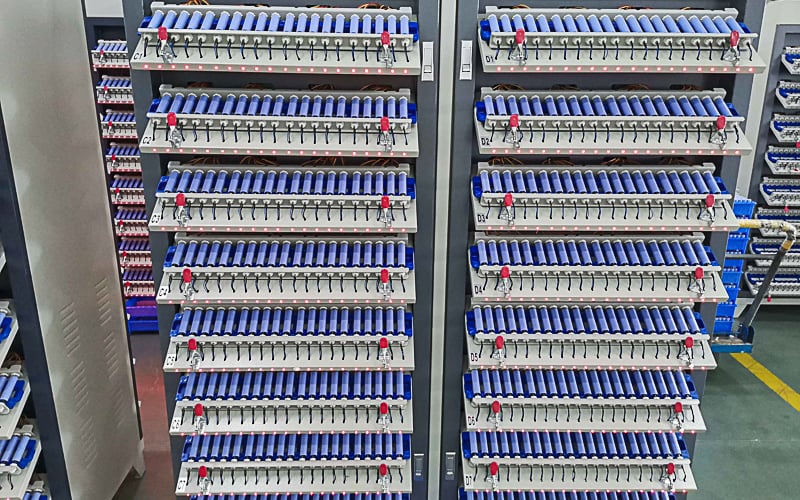Supplying custom battery packs to companies in aerospace, medical, military, oceanography, and other industries requires the skills and technical expertise provided by quality manufacturers such as Epec. Yet, the design and build of the battery pack is often only part of the customer's order.
In addition, Epec also provides battery chargers and custom charging services to ensure that the battery packs are at safe charge levels based on several factors, such as battery chemistry and the type of charge that is necessary. In this blog post, we will outline some best practices when it comes to charging a custom battery pack.

Batteries charging on charging racks.
Use the Right Charger for Specific Battery Chemistries
When it comes to battery chargers, we receive several common questions from customers regarding off-the-shelf chargers versus custom chargers. Do they need a custom charger for specific battery chemistries? Can they use a consumer off-the-shelf charger received from a different manufacturer to charge their battery pack? Do the battery packs need specific charges for different battery chemistries?
There was a time when chargers were interchangeable between manufacturers. Decades ago, when older nickel cadmium (NiCd) batteries were commonly used for battery packs, an off-the-shelf charger or one from a different manufacturer could be used for the battery pack.
Today, we have fast-charging NiCd batteries possessing rates of 1c to 4c, nickel metal hydride (NiMH) chemistries and lithium ion-based batteries available. Ensuring that battery packs do not become overcharged while providing faster charge times have caused the need for more customized battery charger solutions that are tailored to the battery pack chemistry requested by the customer.
Also, keep in mind that battery chargers are not interchangeable for different chemistries. While it is true that a NiMH charger can charge a NiCd battery pack, you would never want to use NiCd chargers to charge NiMH chemistries as it overcharges the battery packs.
Customer chargers do not always provide the right charge and do not always terminate the charge once reaching full capacity. So, the batteries begin the heat up until experiencing thermal runaway and venting of the build-up gases.
Different battery chemistries will require specific charge rates based on their design in the battery pack. The most common charges for specific chemistries are as follows:
Constant Current for NiCd and NiMH Chemistries: Constant current charges will offer a varied charge to provide a constant current flow and then will switch off once reaching a full voltage charge.
- Constant Voltage for Lithium-Ion Based Chemistries: Constant voltage offers a DC power supply that has a step-down transformer and rectifier to provide a DC voltage flow.
- Trickle Charge for Long Storage: Trickle charges provide a continuous constant current charge to prevent the self-discharge of batteries. This charge is not suitable for lithium ion or NiMH chemistries.
- Float Charge for Lead Acid Chemistries: Float charges involve a permanent parallel connection between the battery and the load across a DC charging source. A constant voltage is used that is lower than the battery's upper voltage limit.
Ensuring Safe Charging with Lithium-Based Chemistries
Lithium battery packs are becoming more common in electronics and applications requiring high-powered batteries and fast charge rates. Yet, special considerations must be taken when charging lithium chemistries to prevent permanent damage.
Lithium battery packs should never be overcharged. A continuous charge, even as a trickle charge, can cause the metallic lithium to plate along the anode inside the battery and cause voltage stress. The battery can become unstable as the cathode material will create carbon dioxide. The pressure in the battery pack will start to increase as well as the temperature until bursting open the safety membrane as it can possibly catch fire.
Most battery pack manufacturers will install protection devices for lithium chemistries, as well as nickel-based chemistries. One protection device, called a current interrupt device (CID), will cut off the electrical circuit when detecting high temperatures, high voltages, or excessive cell pressures. When the electrical circuit is cut off, the current flow will become disconnected as the built-up gases can vent. Other devices include solid-state switches.
Understanding Battery Aging
Battery cells deteriorate over time. The length of time the battery is put into use as well as the charge/discharge rates eventually impacts the energy storage capacity of the batteries. This problem is especially prevalent in lithium chemistries.
The rate of the battery aging process will be due to a variety of factors. These factors may involve:
- Using or storing cells in high-temperature environments
- Charging cells in low-temperature places
- Extreme cell cycling beyond the preferred operating voltage range
- High charge currents
- Storing battery packs at full charge for long lengths of time
A common sign that a battery has aged is that it will not charge to its full capacity. The battery pack may also appear warped or enlarged. It may also not hold any charge.
Charging Custom Battery Packs
There are several best practices to use when charging battery packs. Some of these guidelines will be specific to the type of battery chemistry that is put into use.
- Use the correct charger based on the battery's chemistry.
- Charge the battery when its state-of-charge (SoC) is low and terminate the charge once reaching full capacity.
- Trickle charges should only be used for NiCd chemistries and certain lead acid batteries. They should not be used for lithium or NiMH.
- Float charges can be used for lead acid batteries and should not be used for lithium chemistries.
- Charge batteries at room temperature as charging should not occur at low temperatures.
- Always check the battery's temperature. Nickel-based batteries will grow warm when charging and then go through a cool down period at full charge. Lead acid chemistries will maintain a lukewarm temperature.
- Stop charging a lithium battery if it is excessively warm.
- A partial charge is suitable for lithium chemistries as they do not always need to be fully charged.
Getting the Appropriate Charger
Since every battery manufacturer will be following the specifications offered by the customer when developing the custom battery pack, they should also speak with the manufacturer regarding obtaining chargers. Obtaining a custom charger and battery pack that matches each other will help to avoid insufficient battery run times as well as battery cycle life issues.
In addition, obtaining a custom battery pack and a charger from separate companies can be costly when issues arise. A customer will first have to discover which product is at fault: the charger or the battery pack. Then they must determine what the main problem is to provide the appropriate remediation procedures. When working with one company supplying both battery packs and chargers, cost controls are easier to manage, changes can be quickly made to the specific product, and testing can commence to ensure that the charger will provide the right charge rate and flow to the battery packs.
Battery pack chargers can be custom developed or, many off-the-shelf chargers are available for a range of chemistries including NiCd, NiMH, lithium-ion, lithium metal and SLA. All the battery chargers should be compliant with CSA, UL, and CE standards.
Summary
Most end users expect that the electronics and products are ready to use once obtaining them. Unless there are specifications where the battery pack must be completely discharged or partially charged when shipping, the battery pack should be ready to be placed into the application immediately.
Custom battery pack manufacturers can provide battery charging services to customers. This service is highly desired when a customer needs high-volume custom battery packs and chargers for their end clients. They will use a range of different charges based on the battery pack chemistry and the customer's specifications. Then, the rechargeable batteries will be delivered so they can be placed immediately into the specific end product.
Key Takeaways
- Use chemistry-specific chargers: Each battery chemistry requires a tailored charging method (constant current for NiCd/NiMH, constant voltage for lithium-ion, trickle for NiCd/lead acid, float for lead acid), and mixing chargers between chemistries can cause overcharge or damage.
- Prioritize lithium safety: Lithium-based chemistries must never be overcharged or trickle charged, as this can lead to plating, gas buildup, thermal runaway, or fire. Protection devices such as current interrupt devices (CID) and solid-state switches are often integrated for safety.
- Account for battery aging: Cells naturally lose capacity over time due to high or low-temperature charging, excessive cycling, high charge currents, and prolonged storage at full charge, with lithium packs being especially vulnerable.
- Follow proper charging conditions: Charge at room temperature, monitor pack temperature, terminate charging at full capacity, and avoid improper use of trickle or float charging on chemistries that are not designed for them.
- Pair chargers with packs from the same source: Using a custom charger from the same manufacturer as the battery pack ensures compatibility, reduces troubleshooting costs, and simplifies testing, helping to maximize battery performance and cycle life.
















